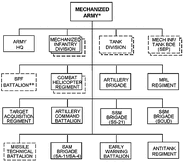The Warsaw Pact Army TOE represents the Army (NATO Corps) and Division organization of Warsaw Pact forces.[1]
Army[]
The army is the largest standing combined arms formation. Armies are capable of independent operations, but normally fight as part of an army group. In the latter case, an army typically receives combat support and combat service support assets from the parent army group. Allocation of such assets depends on the role of a particular army in the army group plan. There are two basic types of ground maneuver armies: the mechanized army and the tank army. Neither type has a fixed structure; the exact size and composition depend on the army's mission, the situation, and the area of operations.
The Warsaw Pact "Army" is equivilent to a NATO Corps.
Tank Army[]
A typical tank army has two to five divisions, with four being the most common. These generally include at least two tank divisions and no more than one mechanized infantry division. In lieu of one or two of these divisions, the army may have one or two separate tank or mechanized infantry brigades.
The Main Intelligence Directorate of the General Staff controls all special-purpose forces (SPF). It may allocate up to a battalion of SPF to support the operations of an army.
Mechanized Army[]
A typical mechanized army has two to five divisions, with four being the most common. These generally include at least two mechanized infantry divisions and one tank division. In lieu of one or two of these divisions, the army may have one or two separate mechanized infantry or tank brigades.
The Main Intelligence Directorate of the General Staff controls all special-purpose forces (SPF). It may allocate up to a battalion of SPF to support the operations of an army.
Infantry Army[]
A typical Infantry Army has four divisions. Organizations vary form four ID, to three ID and one MID, to two ID plus one MID and one TD. The last is the most common form
Air Army[]
An air army has no fixed organization and may tailor its structure to meet specific needs of the ground forces within the supported army group. The numbers of aircraft can vary greatly, even down to the squadron level. Units with aviation (AVN) in their name generally consist of fixed-wing aircraft.
The Air Ambulance Regiment normally has about 15 Mi-8T/HIP C or Mi-8MT (Mi-17)/HIP H medium helicopters equipped as air ambulances.
Divisions[]
The ground forces have three basic types of maneuver division: the mechanized infantry division, the tank division, and the motorized infantry division. The divisions are combined arms organizations.
Tank Division[]
A tank division has one IFV-equipped mechanized infantry brigade along with its three tank brigades. Combat support and combat service support units are basically the same for all mechanized infantry and tank divisions. The only differences are variations in the compositions of the self-propelled artillery regiment and maintenance battalion, and the fact that the tank division has no antitank battalion.
Mechanized Division[]
A mechanized infantry organization has one tank brigade along with its mechanized infantry brigades. The latter may comprise two IFV-equipped brigades and one APC-equipped brigade or vice versa. Combat support and combat service support units are basically the same for all mechanized infantry and tank divisions. The only differences are variations in the compositions of the self-propelled artillery regiment and maintenance battalion, and the fact that the tank division has no antitank battalion.
Motorized Division[]
The basic maneuver units in this division are three motorized infantry brigades (divisional). These divisional brigades differ structurally from their separate counterparts normally found within military districts. In addition to its motorized infantry brigades, this division may or may not have a separate tank battalion.
Most motorized infantry divisions have an ATGM battery and company-sized engineer, signal, reconnaissance, and medical units. However, some better-equipped motorized infantry divisions may have battalion-sized antitank, engineer, signal, reconnaissance (and EC), and medical units.
Motorized infantry divisions are more common than mechanized or infantry divisions.
Infantry Division[]
The basic maneuver units in this division are infantry brigades (divisional). Divisional brigades differ structurally from their separate counterparts normally found within districts. In rare cases, an infantry division may include a separate tank battalion.
Most infantry divisions have company-sized engineer, signal, reconnaissance, and medical units. However, some better-equipped infantry divisions may have battalion-sized units of these types.
Infantry divisions are less common than motorized infantry divisions.
Airborne Division[]
The material support battalion also performs the parachute rigging function for the division elements other than the airborne brigades. The brigades each have their own parachute rigging and resupply company.
TOE charts[]
Notes and references[]
- ↑ ST 100-7 OPFOR Battle Book, US Army Command and General Staff College








